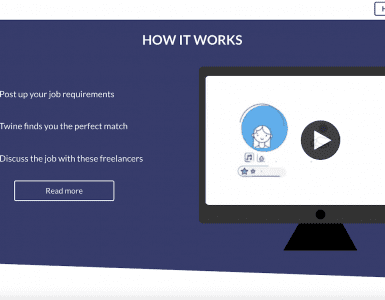Managing a freelancer can be very different to managing a permanent employee. The experience can be different again depending on whether your freelancers are remote workers or contracting from your office space. Freelancers aren’t formally under your control. They aren’t subject to the same rules and conditions that your permanent employees are, so they need to be managed differently. What’s more, freelancers often like to be managed differently, or require different levels of contact and motivation. Here’s our handy guide to making sure you manage your freelancer right:


Make a shortlist of freelancers:
You can pretty much guarantee that if you need a freelancer to start on a project tomorrow, no one will be available. It’s worth getting together a list of good freelancers well in advance. Start building relationships with them well before it’s time for you to hire. This way you can work out their schedule, and find out when they’d be available to work for you. Plus, they’ll be more likely to accept a project from someone they’re on good terms with. You’ll find it easier to manage someone you’re already familiar with.
Hire the right freelancer:
Getting the right freelancer for your project can make managing them a whole lot easier. Hire someone who believes in your company values: they’ll understand your project right from the get-go, and you’ll have less explaining to do to bring them up to speed.
Sounds like an obvious one, but make sure you hire a freelancer with the right skills. That illustrator might say they can design your website, but it’s not their area of specialism. Hiring a specialist means that they’re definitely the right person for the job.
Great freelancers are hot commodities. Make them want to work for you more than anyone else – Hubspot
Don’t hire someone over or underqualified. If you give a project that’s too simple to a senior level freelancer, you might think that because they’re an experienced pro they’ll get your project done in double-quick time. What will actually happen is they’ll take longer with it as they fit it around more exciting projects that are more fulfilling to them.


Get a freelance policy in place:
Before you hire a freelancer, make sure you know how you’re going to cope with any work-related situations that may arise. Sickness, lateness, expenses, any benefits, working hours, dress code… anything that you’d normally have to brief a permanent employee on applies here. Don’t wait for these situations to happen before you decide what your policy will be. There’s nothing worse than being asked a work-related question by your freelancer and not having the answer to hand.
Write a good specification:
Do this, and you should be able to manage your freelancer smoothly, provided you’ve hired the right person for the job. Your project specification is a document that contains a summary of your project, the project requirements, scope, deadlines, context and background research etc. Our guide to writing the perfect project brief will help you out here.
Set expectations:
Let your freelancer know what you want them to do and how they should do it. It’s important to provide context for the project they’re working on. Your freelancer is an expert in their field but they’re not an expert in your business. They need to be brought up to speed on your company values, culture and protocol. Remote freelancers aren’t in the office soaking up the atmosphere, overhearing business conversations and decisions. Remember to be explicit with them and bring them up to speed wherever necessary.
Freelancers are not employees; they are independent consultants who can work wherever and whenever they want. Your best bet as a small business owner is to manage them by communicating effectively and by setting consistent deadlines – John Boinott
A good way to manage is to let your freelancers know what’s expected of them. Don’t assume they know this already, even if it seems obvious. If you expect them to be online by 8.30, state this when you hire them. If they need to Skype into your weekly team meetings, make sure they know this.


Out of sight out of mind:
If your freelancer is working remotely, it can sometimes be a case of out of sight out of mind. Don’t forget about them. This can make them feel ostracised from the team. Making them feel like part of the team is essential to managing your freelancer well.
Your freelancer should be checking in with you on a regular basis to make sure the project is heading in the right direction. If this isn’t happening, make sure you are the one to instigate contact.
Make it clear who they report to:
If your freelancer is remote, they won’t be aware of the hierarchical structure in your company, and may even be confused about who they report to. Make this clear from the offset. The last thing you want is another company employee stepping in and giving your freelancers orders without your consent.
Use a time tracking tool:
If you’re concerned about tracking what your remote freelancer is working on and when, consider using a time tracking tool to clarify and manage their billable hours. You’ll be able to see exactly how long they’ve spent working on your project. There are numerous tools available, all with different features and price points. Try Harvest, Toggl and MyHours for starters.


Email FTW!
In the wrong hands, email can become a force for evil. We’ve all been there – you log in to find your inbox full to bursting after you’ve been cc’d into 20 irrelevant round robins. But, used rightly, it can be a successful tool to help manage your freelancer.
Lay the ground rules. Set out what email is used for in your company. If you use other methods of communication, such as Slack, lay down what each of your channels is used for. Eg.; Slack is for questions, requests and chat, email is for sending project specs and file drafts.
If your company has a culture of emailing out of office hours, ask your freelancer whether this is ok. Some people are cool with receiving a late-night email, others not so much (especially if they have a young family).
Let them know the times when you check your emails. That way you can be sure your freelancer won’t miss an important deadline, say for example, if you check your emails at 4.30pm and they email at 5pm.
Keep your messages succinct. Don’t waffle. Your freelancer should be able to get straight to the point of your email message without having to read 10 paragraphs.
Make email contact daily, and use it as a method of checking in with your freelancer. Resist the urge to email several times a day.


Don’t micromanage:
People often choose to become freelancers because they want to break free of the constraints of the office and become their own manager. You’ll find that most freelancers are fairly autonomous and won’t receive heavy-handed management or micromanagement well. Try and be flexible. Remember too, that you won’t be their only client. Freelancers often juggle a few projects at once.
The bottom line is, a good freelancer shouldn’t need too much management from you. If you find yourself spending a lot of time managing someone, or hand-holding, perhaps look for someone else.
How do they like to be managed?
It can’t hurt to ask. Ask your freelancer what style of management works best for them and what they’re used to working with. You can both have input on this process and come to an arrangement that suits you both.


Give feedback:
This is an important one. Give feedback little and often. Our article on how to give feedback to your freelancer explains this topic in further detail.
Be open and transparent:
If freelancers get uneasy about their position or think that the work might be drying up, they’ll look to leave. If you want to keep them on, seek to reassure them. Be open about upcoming work prospects in your company.
Encourage them:
Let them know how important the work they are doing is to you and your company. And, what a great job they’re doing, of course. Freelancers can often lack a wider business context. Although they have knowledge of the project they’re working on, they might not be clued up entirely on how it impacts your company as a whole. So let them know they count too.
Pay them on time:
There is no quicker way to lose a freelancer forever than by not paying them on time. Your freelancer will value this above most other things you can provide.


Care about your freelancer:
Your freelancer is more than just a dependable workhorse. Freelancers have a lot of clients, and before long projects can start to become transactional. Communication happens digitally rather than face to face, so a little personal encouragement goes a long way.
Make them feel part of your team – freelancing can be an isolating profession. Invite them to come into the office. Perhaps they could come along to a team lunch? Make sure they’re invited to meetings (even if it’s just Skype).
You’ll go above and beyond just being their manager if you show you genuinely care about your freelancer. Why not make sure you’re the client they remember? Build a solid business relationship with your freelancer and they’ll come back to you time and again.



